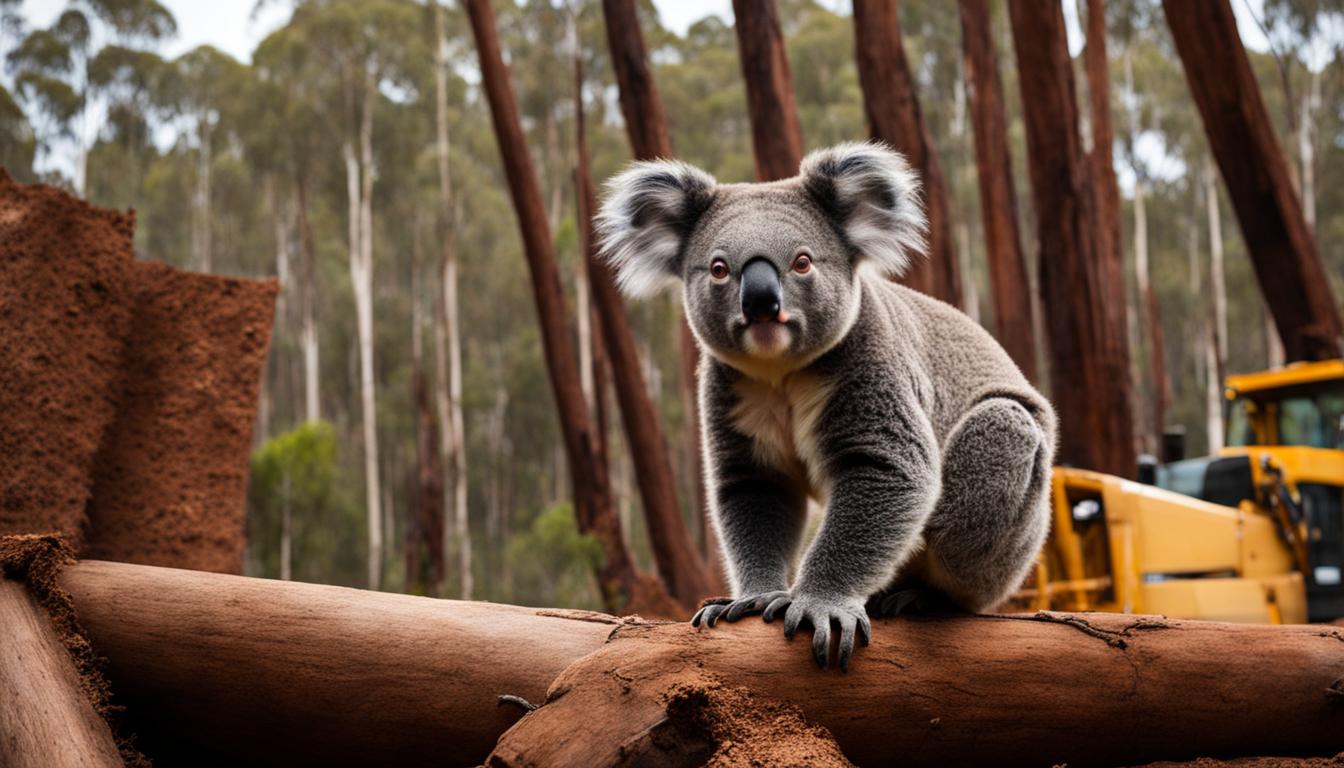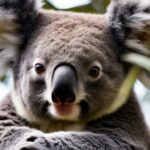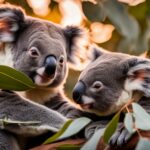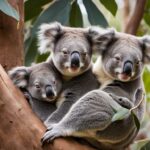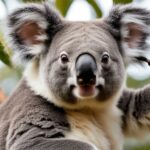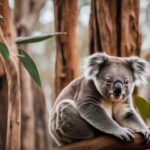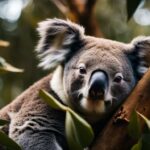Wild koala populations face numerous challenges that threaten their survival. From habitat loss to increasing human encroachment, these adorable marsupials are under constant pressure.
European settlement in Australia has resulted in the destruction of more than four-fifths of the original koala habitat. This habitat loss poses the greatest threat to their existence. Land clearing for human settlement, agriculture, mining, and roads has significantly reduced the availability of eucalyptus forests, which are crucial for koalas’ survival.
With the loss of their natural habitat, koalas face increased competition for food and territory from other wildlife. The disturbance caused by humans, injury or death from traffic and domestic dogs, and the harmful effects of garden pesticides in waterways further compound their challenges. Additionally, increased stress levels make them more susceptible to disease.
These threats to wild koala populations highlight the urgent need for conservation efforts. By understanding and addressing these challenges, we can play a crucial role in preserving the future of these iconic creatures.
Clearing of Land and Habitat Loss
The clearing of land for various purposes, such as agriculture, housing, mining, forestry, and infrastructure, has had a detrimental impact on koala populations. This uncontrolled land clearing has resulted in significant habitat loss, with over 80% of the original koala habitat being destroyed. The expansion of human settlement and the need for resources have led to the destruction of eucalyptus forests, which are crucial for the survival of not only koalas but also other wildlife.
“The destruction of koala habitat has resulted in increased disturbance by humans, injury or death from traffic and domestic dogs, and increased stress making them more susceptible to disease.”
The consequences of habitat loss are severe. Koalas face increased competition for food and territory due to overcrowding, leading to further threats to their survival. The loss of eucalyptus forests also disrupts their natural habitat and migration patterns, making it difficult for them to find suitable sources of food and shelter. Furthermore, the destruction of their habitat increases their vulnerability to disease outbreaks, as stress weakens their immune systems.
The Impact of Habitat Loss on Koalas
Habitat loss has forced koalas to adapt to living in fragmented and isolated areas, often surrounded by human development. This brings them into closer contact with humans, increasing the risks of injury or death from traffic and domestic dogs. As urbanization continues to expand, koalas are forced to cross roads and move through developed areas, further endangering their lives.
The loss of habitat also disrupts the delicate balance of ecosystems, as eucalyptus forests provide food and shelter to a wide range of wildlife. The destruction of these forests to make way for human activities not only affects koalas but also negatively impacts the biodiversity of the entire ecosystem. Protecting and preserving their habitat is crucial for the survival of koalas and the overall health of our natural environment.
Bushfires and their impact on koalas
Koalas, being highly vulnerable to bushfires, face significant risks to their population and habitat. In areas where koala populations live in bushland surrounded by human development, the threat of bushfires is particularly high. The consequences can be devastating – an entire colony of koalas could be wiped out in a single fire.
Bushfires not only result in the immediate loss of koalas due to the flames but also lead to the destruction of their habitat. The loss of habitat exacerbates the already threatened status of koalas, as they struggle to find suitable places to live and access their primary food source, eucalyptus leaves.
“The risk of bushfires to koala populations is a critical concern, especially as urbanization continues to encroach upon their natural habitat,” says Dr. Emily Wilson, a wildlife conservation expert. “Efforts must be made to manage bushfire risks and ensure the safety and preservation of koala populations.”
Without proper measures to address the fire risk, the future of koalas remains uncertain. Conservation efforts need to focus on minimizing the occurrence of bushfires and implementing strategies to protect and restore koala habitats affected by fires.
Table: Impact of Bushfires on Koalas
| Effects | Consequences |
|---|---|
| Immediate loss of koalas | Death or injury due to the flames |
| Destruction of habitat | Loss of food sources and suitable living environments |
| Increased vulnerability | Struggle to find safe places to live and access resources |
Koala Diseases and Their Effects on Populations
As adorable as koalas are, they are not immune to diseases that can have a significant impact on their populations. One of the most common diseases among koalas is chlamydia, which can cause various health issues including conjunctivitis, pneumonia, urinary tract infections, and reproductive tract infections. Stress resulting from habitat reduction can worsen the impact of diseases on koala populations, making them more vulnerable to infection and the adverse effects of chlamydia.
“Chlamydia is a major concern for koalas and can lead to severe health problems,” explains Dr. Emily Collins, a wildlife veterinarian. “It can affect their eyes, respiratory system, and reproductive organs, leading to infertility, pneumonia, and even death in severe cases.”
In addition to chlamydia, koalas are also prone to other diseases, including various forms of cancers such as leukemia and skin cancers. Disease outbreaks can further contribute to the decline of koala numbers, as weakened individuals are more susceptible to infections and less capable of surviving in the wild.
Protecting Koala Populations from Disease
Efforts to safeguard the health of koalas involve a combination of preventive measures and proactive intervention. Wildlife conservation organizations work closely with veterinarians and researchers to monitor and manage diseases in koala populations, implementing vaccination programs and providing medical treatment for infected individuals.
Public awareness and education campaigns are also crucial in promoting responsible interactions with koalas and raising funds for research and conservation initiatives. By understanding the impact of diseases on koalas and supporting efforts to combat them, we can help protect these unique and beloved creatures for future generations to enjoy.
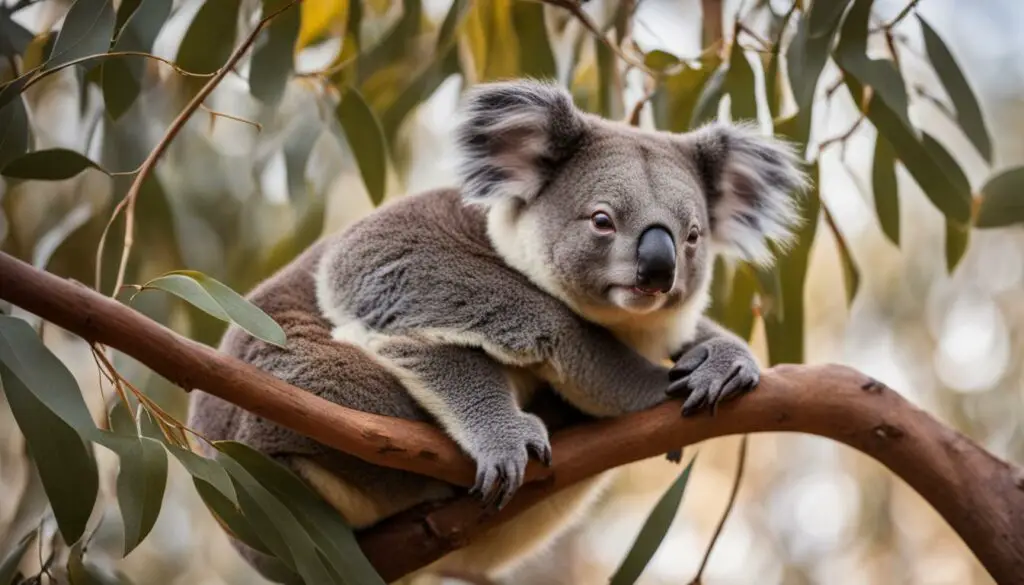
Koala Predators and the Threat of Feral Animals
Koalas face a range of challenges in their natural habitat, including the presence of predators and the threat posed by feral animals. While natural predators such as goannas, dingoes, powerful owls, and pythons may occasionally prey upon juvenile koalas, their impact on wild populations is not significant. However, the introduction of feral animals, such as foxes and large feral cats, has emerged as a major concern, particularly for young koalas. These invasive species can pose a serious threat to the survival and well-being of koalas, exacerbating the existing pressures they face.
The decline of koala populations has been observed during times of drought, when resources are scarce and competition for food becomes more intense. The added presence of feral animals further compounds this issue, as they not only compete with koalas for limited food sources but also pose a direct threat through predation. The impact of feral animals on koalas is particularly pronounced in regions where human development has encroached upon their natural habitats, further restricting their access to resources and increasing their vulnerability.
“The introduction of feral animals has emerged as a major concern, particularly for young koalas.”
Efforts to control and manage feral populations are crucial for the long-term survival of koalas. Conservation organizations and local communities are working together to implement strategies aimed at reducing the impact of feral animals on koala populations. These initiatives include the establishment of predator-proof enclosures, the development of targeted trapping and removal programs, and the implementation of education and awareness campaigns to promote responsible pet ownership and discourage the release of unwanted pets into the wild.
| Feral Animal | Impact on Koalas |
|---|---|
| Foxes | Direct predation on juvenile koalas |
| Large feral cats | Direct predation on juvenile koalas |
| Competition for resources | Increased competition for limited food sources |
Protecting koalas from the threat of feral animals requires a multi-faceted approach. Alongside efforts to control feral populations, it is essential to address the root causes of their introduction and proliferation. This includes addressing issues of pet abandonment, promoting responsible pet ownership, and implementing rigorous biosecurity measures to prevent the spread of invasive species into koala habitats. By taking a comprehensive approach to managing feral animals, we can help ensure the survival of koalas and preserve their place in our natural ecosystem.
Impact of Urbanization and Human Encroachment
Urbanization and human encroachment present significant challenges to wild koala populations. As human settlements expand, koalas are increasingly forced to navigate through developed areas, putting them at risk of various dangers.
One of the main threats is the increased risk of koalas being hit by cars as they cross roads. The expansion of urban areas has led to an increase in traffic, making it more difficult for koalas to move safely between their fragmented habitats. The consequences can be devastating, not only for individual koalas but also for the population as a whole.
Another concern is the heightened risk of koalas being attacked by domestic dogs. As more land is developed for housing, the natural habitats of koalas are being encroached upon, bringing them into closer contact with human settlements. This proximity increases the likelihood of conflict with domestic pets, which can cause severe injuries or even death for these vulnerable marsupials.
Furthermore, backyards in urban areas can pose unexpected dangers for koalas. Fences that block their movement can hinder their ability to access suitable feeding and breeding grounds. Additionally, swimming pools present a risk of drowning, as koalas may mistake them for water sources. These hazards further contribute to the challenges faced by koala populations in urbanized environments.
The Impact of Urbanization and Human Encroachment on Koala Populations
The urbanization and encroachment of human activities on koala habitats have had detrimental effects on their populations. Increased road traffic and the presence of domestic dogs have resulted in a higher mortality rate among koalas. Similarly, the barriers created by fences and the risk of drowning in backyard swimming pools have hindered their ability to move freely and access essential resources.
To better understand the impact of urbanization and human encroachment, let’s take a closer look at the following table:
| Urbanization | Human Encroachment | |
|---|---|---|
| Increased Road Traffic | Higher risk of koalas being hit by cars | – |
| Presence of Domestic Dogs | Increased likelihood of koala attacks | – |
| Barriers created by Fences | – | Hindered movement and access to resources |
| Risk of Drowning in Swimming Pools | – | Potential danger for koalas |
As shown in the table, urbanization and human encroachment have distinct impacts on koalas. While road traffic and domestic dogs pose significant threats in urban areas, the presence of fences and swimming pools in human-occupied spaces hampers koalas’ movement and survival.
It is crucial to recognize the consequences of urbanization and human encroachment and take proactive measures to mitigate these risks. By implementing initiatives such as wildlife corridors, speed limit reductions in koala habitat areas, and responsible pet ownership programs, we can help protect and preserve koala populations in the face of rapid urban development.
“The expansion of human settlements poses significant challenges to koala populations, increasing the risk of road accidents and encounters with domestic dogs. Fences and swimming pools in urban areas further impede their movement and survival.”
Climate change and its implications for koalas
The increasing impact of climate change poses significant challenges for koalas and their habitats. Rapid changes in weather patterns, including more frequent droughts, have profound implications for the availability and quality of koala habitat.
One of the primary concerns is the increased vulnerability of koalas during periods of drought. As water sources become scarce and eucalyptus leaves lose their nutritional value, koalas struggle to find sufficient food and water to sustain themselves. This can lead to malnutrition, weakened immune systems, and reduced reproductive rates among koalas.
Furthermore, climate change is contributing to the intensification of bushfires, which pose a significant threat to koalas. The combination of hotter and drier conditions creates the perfect environment for fires to spread rapidly, destroying vast areas of koala habitat in their wake. The loss of habitat not only reduces the available food and shelter for koalas but also exposes them to increased risks of injury, stress, and predation.
The Impact of Climate Change on Koala Habitat Availability
It is essential to understand the impact of climate change on the availability of suitable habitat for koalas. Rising temperatures, shifting rainfall patterns, and increased frequency of extreme weather events can alter the distribution and suitability of eucalyptus forests, which are vital for the survival of koala populations.
| Impact | |
|---|---|
| Increased temperatures | May reduce the suitability of eucalyptus leaves as a food source, resulting in decreased nutritional value and potential food scarcity for koalas. |
| Shifting rainfall patterns | Altered rainfall patterns can affect the growth and health of eucalyptus trees, potentially leading to reduced habitat availability for koalas. |
| Extreme weather events | Events such as cyclones and storms can cause physical damage to koala habitat, further reducing their available resources. |
The combined effects of climate change, including droughts, bushfires, and habitat loss, make it essential to take proactive measures to mitigate the impact on koala populations. Conservation efforts should focus on preserving and restoring suitable habitat, implementing strategies to minimize the risk of bushfires, and ensuring adequate water sources for koalas during drought periods.
As the world continues to grapple with the consequences of climate change, it is crucial to recognize the unique challenges faced by koalas. By taking action to address the threats posed by climate change and preserving their habitat, we can help ensure a sustainable future for these iconic and beloved creatures.
Conclusion
The threats faced by wild koala populations, such as habitat loss, bushfires, disease, predation, urbanization, and climate change, are placing these iconic creatures in great jeopardy. To ensure the survival of koalas, it is crucial to focus on the conservation and preservation of their habitats.
Minimizing land clearing is essential in maintaining suitable habitats for koalas. Additionally, managing the impact of bushfires can help prevent devastating loss of populations and their habitats. Addressing disease outbreaks and controlling feral animals are crucial steps in protecting the well-being of koalas.
The effects of urbanization and climate change also pose significant challenges. By mitigating the impact of urbanization, such as reducing the risk of koalas being injured by cars and attacked by dogs, we can enhance their chances of survival. Moreover, addressing the implications of climate change, including increased drought frequency and the reduction of nutritional quality in eucalyptus leaves, is crucial in ensuring koalas have access to adequate food resources.
Preserving the habitat of wild koala populations is of utmost importance. By recognizing and addressing the threats they face, we can actively contribute to the conservation of these unique and beloved creatures, securing their place in our natural world for future generations.
How Do Natural Predators Affect the Threats Facing Wild Koala Populations?
Natural predators of koalas play a significant role in the threats facing wild koala populations. Predators like dingoes and domestic dogs can pose a serious risk to koalas, especially in areas where their habitat is fragmented. This highlights the need for conservation efforts to mitigate these threats and protect koala populations.
FAQ
What are the primary threats facing wild koala populations?
The primary threats facing wild koala populations include habitat loss, bushfires, disease, predation, urbanization, and climate change.
How does clearing of land contribute to habitat loss for koalas?
Clearing of land for purposes such as agriculture, housing, mining, forestry, and infrastructure has resulted in significant habitat loss for koalas, making them more vulnerable to threats such as increased disturbance by humans, injury from traffic and domestic dogs, and competition for food and territory.
What is the impact of bushfires on koala populations?
Koalas are highly vulnerable to bushfires, and if a population is surrounded by development, an entire colony could be wiped out in a single fire. Bushfires can lead to significant loss of koala populations and destroy their habitat, exacerbating their already threatened status.
What diseases affect koala populations?
Chlamydia is a common disease among koalas and can cause various health issues, such as conjunctivitis, pneumonia, urinary tract infections, and reproductive tract infections. Stress resulting from habitat reduction can worsen the impact of diseases on koala populations. Additionally, koalas are prone to a range of cancers, including leukemia and skin cancers.
Do predators pose a significant threat to koalas?
While natural predators like goannas, dingoes, powerful owls, and pythons can prey upon juvenile koalas, they do not significantly impact wild populations. However, feral animals, such as foxes and large feral cats, can pose a threat, particularly to young koalas. The decline in koala populations has also been observed during times of drought.
How does urbanization and human encroachment affect koala populations?
Urbanization and human encroachment pose significant challenges to koala populations. As human settlements expand, koalas are forced to cross roads and move through developed areas, increasing their risk of being hit by cars and attacked by dogs. Backyards can also present dangers, such as fences that impede koalas’ movement or the risk of drowning in pools.
What are the implications of climate change for koalas?
Climate change poses various threats to koalas. Increasing drought frequency and high fire-danger weather can force koalas to move more frequently, increasing their vulnerability to predators and vehicles. Rising atmospheric CO2 levels can also reduce the nutritional quality of eucalyptus leaves, potentially leading to food scarcity for koalas.
Why is protecting and preserving koala habitat crucial?
Protecting and preserving koala habitat is crucial for their survival. Efforts should be made to minimize land clearing, manage the impact of bushfires, address disease outbreaks, control feral animals, and mitigate the effects of urbanization and climate change. By recognizing and addressing these threats, we can contribute to the conservation of these unique and iconic creatures.

